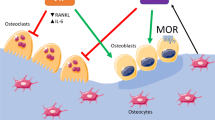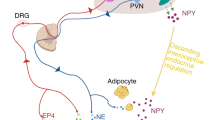Abstract
We have examined the effect of the μ-opioid analgesic buprenorphine on osteoclastic bone resorption in vitro and in the rat adjuvant arthritis model. In the bone slice assay buprenorphine inhibited osteoclastic bone resorption with an IC50 of 1 μM. This effect was not mimicked by the μ-opioid agonist ([D-Ala,N-Me-Phe, Gly-ol]-enkephalin and was not prevented by the μ-opioid antagonist naloxone. Since other agents that inhibit osteoclastic bone resorption, such as bisphosphonates and calcitonin prevent bone erosion in the rat adjuvant arthritis model, we also examined the effect of buprenorphine in this model. Surprisingly, buprenorphine exacerbated inflammation measured by paw volume and increased joint destruction assessed by X-ray scores, in the injected paws and particularly in the non-injected paws. These studies also show that attempts to ameliorate animal suffering in this chronic model by using centrally acting analgesics such as buprenorphine may lead to complications in interpreting screening results obtained with novel, potential anti-arthritic compounds.
Similar content being viewed by others
References
Apte RN, Durum SK, Oppenheim JJ. Opioids modulate interleukin-1 production and secretion by bone-marrow macrophages. Immunol Letts 1990;24:141–8.
Chambers TJ, Hall TJ. Cellular and molecular mechanisms in the regulation and function of osteoclasts. Vitam Horm 1991;46:41–86.
Hattersley G, Owens J, Flanagan AM, Chambers TJ. Macrophage colony stimulating factor (M-CSF) is essential for osteoclast formation in vitro. Biochem Biophys Res Comm 1991;177:526–31.
Jaffe JH, Martin WR. In: Gilman AG, Goodman LS, Rall TW, Murad F, editors. The pharmacological basis of therapeutics. New York, Toronto, London: Macmillan Publishing Co., 1985:523–4.
Chambers TJ, McSheehy PMJ, Thompson BM, Fuller K. The effect of calcium-regulating hormones and prostaglandins on bone resorption by osteoclasts disaggregated from neonatal rabbit bones. Endocrinology 1985;116:234–9.
Hall TJ, Schaeublin M, Chambers TJ. Na+/H+-antiporter activity is essential for the induction, but not the maintenance of osteoclastic bone resorption and cytoplasmic spreading. Biochem Biophys Res Comm 1992;188:1097–103.
Sambrook PN, Reeve J. Bone disease in rheumatoid arthritis. Clin Sci 1988;74:225–30.
Gough AKS, Lilley J, Eyre S, Holder RL, Emery P. Generalised bone loss in patients with early rheumatoid arthritis. Lancet 1994;344:23–7.
Francis MD, Hovancik K, Boyce RW. NE-58095: A diphosphonate which prevents bone erosion and preserves joint architecture in experimental arthritis. Int J Tiss Reac 1989;11:239–52.
Harada Y, Wang JT, Gorn AH, Gravallese EM, Thornhill TS, Jasty M, et al. Identification of the cell types responsible for bone resorption in rheumatoid arthritis. Arthr Rheum 1994;37:S211.
Wiesenberg I, Van Der Meide PH, Schellekens H, Alkan SS. Suppression and augmentation of rat adjuvant arthritis with monoclonal anti-interferon-gamma antibody. Clin Exp Immunol 1989;78:245–9.
Chen Y, Mestek A, Liu J, Hurley JA, Yu L. Molecular cloning and functional expression of a μ-opioid receptor from rat brain. Mol Pharmacol 1993;44:8–12.
Burke TR, Li ZH, Bolen JB, Chapekar M, Gang Y, Glazer RI, et al. Examination of the possible mediation of antineoplastic effects of opiates through the inhibition of tyrosine-specific protein kinases. Biochem Pharmacol 1991;41:R17–20.
Soriano P, Montgomery C, Geske R, Bradley A, Targeted disruption of the c-src proto-oncogene leads to osteopetrosis in mice. Cell 1991;64:693–702.
Hall TJ, Schaeublin M, Missbach M. Evidence that c-src is involved in the process of osteoclastic bone resorption. Biochem Biophys Res Comm 1994;199:1237–44.
Yoneda T, Lowe C, Lee CH, Gutierrez G, Niewolna M, Williams PJ, et al. Herbimycin A, a pp60c-src tyrosine kinase inhibitor, inhibits osteoclastic bone resorption in vitro and hypercalcemia in vivo. J Clin Invest 1993;91:2791–5.
Lydon NB, Gay B, Mett H, Murray B, Liebetanz J, Gutzwiller A, et al. Purification and biochemical characterization of non-myristolated recombinant pp60c-src kinase. Biochem J 1992;287:985–93.
Earl JR, Claxon AW, Blake DR, Morris CJ. Proinflammatory effects of morphine in the rat adjuvant arthritis model. Int J Tiss React 1994;16:163–70.
Stein C, Hassan AHS, Przewlocki R, Gramsch C, Peter K, Herz A. Opioids from immunocytes interact with receptors on sensory nerves to inhibit nociception in inflammation. Proc Natl Acad Sci USA 1990;87:5935–9.
Author information
Authors and Affiliations
Additional information
accepted by I. Ahnfelt-Rønne
Rights and permissions
About this article
Cite this article
Hall, T.J., Jagher, B., Schaeublin, M. et al. The analgesic drug buprenorphine inhibits osteoclastic bone resorption in vitro, but is proinflammatory in rat adjuvant arthritis. Inflamm Res 45, 299–302 (1996). https://doi.org/10.1007/BF02280995
Received:
Revised:
Accepted:
Issue Date:
DOI: https://doi.org/10.1007/BF02280995




